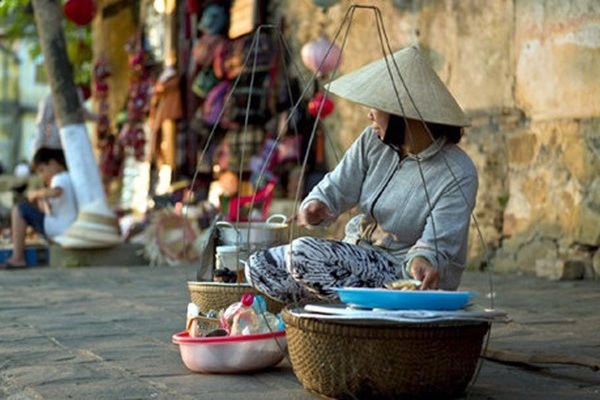CNN has previously highlighted meals like bun rieu (crab paste vermicelli soup), bun cha (rice noodles with grilled pork), and bun ca (fish rice noodles) as must-try Hanoian fare. Near the Cathedral, within Tho Xuong alley, the noodle store shown on this world-renowned TV station can be found.
Bun rieu in Hanoi is just as diverse as pho bo city (beef noodle soup). Visitors to the capital may find bun rieu everywhere, from sidewalk stores, tight nooks, traditional markets, in front of old dorms to luxury restaurants. For centuries, Hanoi's famed Bun Rieu has had a delectable taste that doesn't depend on whether the restaurant is large or little, well-known or secluded, but on the delicate and well-balanced taste.
In spite of being void of fame, Thu Xuong Noodle Shop's bun rieu is well-liked among diners.
Locals and tourists alike go to this popular sidewalk noodle vendor adjacent to the Cathedral. If you're lucky, you'll get to savor a bowl of piping hot bun rieu accompanied by aromatic fermented garlic amid the sound of church bells.
This bun rieu shop is a little business directly outside in the alley that has existed for the past 15 years. Along the walkway are an outdated stainless steel kitchen table and 5-7 worn-out plastic tables and chairs.
Diners here must be adaptable. At rush hour, visitors dine while dodging oncoming traffic. If it starts to rain, they'll have to scurry for cover with their bowl in hand. Despite the obstacles, the store is nevertheless packed, mostly with regulars and locals.
Crab paste, fried tofu, blanched beef, snails, and balut fill Ms. Thu's bun rieu. She accompanies customers according to their preferences: some choose simple, classic tofu, while others prefer full toppings and a wide range of spices.
When asked about her secret, Ms. Thu admitted that she doesn't have one. She simply sells what she and her family would eat and tweaks it until most of her clients are pleased.
Ms. Thu was agitated and worried about her work when the business had to close because of the Covid-19 pandemic. “I kept fidgeting, walking in and out of the house for several months. It was such a discomfort as I've been devoted to this job for so long. I'll miss it if I can't do it.”
Until the outbreak, Ms. Thu's modest sidewalk business sold hundreds, if not 200, of bowls every day! The shop in certain cases, opens from 6 a.m. to 13 p.m, yet Ms. Thu sometimes has to apologize to any customers arriving after 11:30 a.m, since the bun rieu is quickly out of stock.
“My daily output now is limited to a few dozen bowls due to the pandemic, which has reduced the number of visitors significantly. It's still enjoyable, even though sales are down,” she said.
Visitors to this restaurant are drawn to the authentic crab paste, which is served in little portions. According to Ms. Hong, a patron, by eating that little of the crab fat, you can already feel the scent of real field crab.
Her bun rieu uses only fresh crabs purchased from a trusted long-standing supplier. Thu explained that the cost of using frozen crab is half, but she doesn't favor it since the taste isn't up to par.
In addition to the crab, dried shrimp, and thickened vinegar, Ms Thu uses pork bones in her broth, but only a modest amount because overdoing it will make it taste like "bun suon" (pork-rib noodles).
It's the restaurant's mild, slightly tangy vinegar that makes it stand out. “There is no need to buy pre-made onion paste, as I like to make them myself. When it comes to tofu, I'm looking for something that's rich, perfectly fried and fleshy. Vinegar of my choice is aromatic and somewhat sour.”
It costs between VND 25,000 and 55,000 a bowl at Ms. Thu's business. In spite of the shop's size and a smattering of traffic, the bun rieu served here is just divine. The broth soup isn't greasy or overloaded with spices, and its flavorful, mouthwatering, and eye-catching hue makes it a must-try dish. “The beef and tofu here are so good that I often eat more than I need, they are so tender and flavorful,” said Mr. Thanh Hung (Dong Da, Hanoi).
CNN aired images of a noodle shop in the Tho Xuong alley
The bun rieu shop is located right on the sidewalk
Beautifully colored broth from tomatoes without the use of colorants
Onion paste is hand-made by Ms. Thu
The shop's rich and nicely fried tofu is also a big draw for customers
The delectable bun rieu despite the modesty of the setting never fails to satisfy clients.
Linh Trang

Millet rice wafer sought after in nooks and crannies of Hanoi
It was a modest rice wafer topped with sesame and green beans that brought the delicate aroma of Vietnamese food to the table.

Get a sugar rush with this 40-year-old dessert in Hanoi
With traditional flavours of chè (sweet soup) dishes, Chè Bà Thơm has become a famous brand in Quan Thanh Street, Hanoi for more than 40 years, and is still loved by diners today.